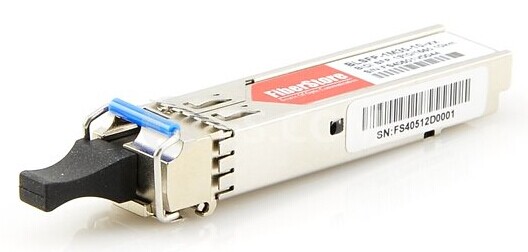Introduction to BiDi Optical Transceivers
In the past few decades, a new class of pluggable optical transceivers have been developed that send and receive optical signals end-to-end over a single fiber strand. This reduces by half the amount of fiber required for that same total data transmission. This factor-of-two improvement can lead to substantial cost savings especially in campus environments with large numbers of connectivity endpoints.
Bi-Directional transceivers, called BiDi’s for short, use two different wavelengths to achieve transmission in both directions on just one fiber. The modules are deployed in pairs, one for the upstream (“U”) direction and another for the downstream (“D”). The standard defining these parts is the IEEE 802.3ah Gigabit Ethernet 1000BASE-BXnn (nn= transmission reach in kilometers) specification for point-to-point Ethernet in the First Mile (EFM) applications.

The value of the BiDi solution derives from the reduction in the use of fibers by a factor of two. There are many situations in real-world networks where this reduction is extremely important if not absolutely required. As mentioned above, the IEEE802.3ah specification defining BiDi’s mentions point-to-point Ethernet in the First Mile (EFM) applications. In addition, BiDi transceivers can be of great use in any situation where only limited fibers or limited conduit space is available. Other common applications include: digital video and Closed Circuit TeleVision (CCTV) applications and high-density switch-to-switch port interconnection.
As mentioned above BiDi transceivers are deployed in matched pairs, one for the upstream (“U”) direction and another for the downstream (“D”), each part transmitting at a different wavelength. The figure below depicts the details of such a matched set of BiDi transceivers. In this example, the two wavelengths utilized by the BiDi pair are 1310nm and 1490nm. Typically the “Upstream” or “U” transceiver transmits at the shorter of the two wavelengths and the “Downstream” or “D” module the longer wavelength.
The key additional technology present in BiDi’s that is not present in standard 2-fiber transceivers is the “Diplexer”. The Diplexer acts simultaneously couples the locally transmitted wavelength onto the single fiber while “splitting” off the received wavelength so it is directed at the receiver.
The value of the BiDi solution derives from the reduction in the use of fibers by a factor of two. There are many situations in real-world networks where this reduction is extremely important if not absolutely required. As mentioned above, the IEEE802.3ah specification defining BiDi’s mentions point-to-point Ethernet in the First Mile (EFM) applications. In addition, BiDi transceivers can be of great use in any situation where only limited fibers or limited conduit space is available. Other common applications include: digital video and Closed Circuit TeleVision (CCTV) applications and high-density switch-to-switch port interconnection.
The simplest economic case for BiDi’s is probably a campus environment requiring fiber connectivity to a large number of endpoints. For example, most universities campuses are spread over a fairly wide area and required high-speed (read: fiber) connectivity between campus core resources (e.g., databases, computing resources, common internet access, etc.) and a large number of classrooms, dorm rooms, and faculty and administrative offices. The following is a simple economic model to demonstrate the savings possible in such an environment using BiDi versus standard 2-fiber transceivers.
So, for a campus environment where average link length is greater than 800 feet, the BiDi solution is the right decision. In an real world example, a large university campus lighting 400 GbE fiber links with an average length of 1600 feet used BiDi’s to save $32,000 versus using 2-fiber transceivers.
FS.COM offers BiDi transceivers in the SFP form-factor supporting 1GbE for all major switch brands like Cisco, HP, Juniper, Extreme, Brocade, etc. We offer a 1Gbps SFP BiDi’s to cover a wide range of distances including: 10km, 20km, 40km, 80km and 120km, all of which are ROHS compliant. To aid in turn-up and maintenance of BiDi links, all FS.COM BiDi transceivers support Digital Diagnostics Monitoring (DDM as defined in standard SFF-8472) allowing real-time monitoring of parameters of the fiber SFP, such as optical output power, optical input power, temperature, laser bias current, and transceiver supply voltage.
Post Your Ad Here

Comments